This mobile phone has all new features with the all new exciting and amazing product specifications. This is not a simple smart phone as we see that the mobile market is the boom for smartphones…….Now this is more than what you want. Thankfully it has a huge AMOLED screen of 4.0 inch which is more visually appropiate for seeing a web page to a high Definition video to a video conferencing……….It has a 5MP camera with HD video recording which gives you a superb way to create your moments with joy. It has many more thing in it’s head like:
1.) when you save the contacts in your phone and once you synchronise your phone with internet your contact list will get it’s own required information like email ids, addresses, phone numbers, their recent activity in social networking site (not in a single account, in more than 2 accounts), you can call them directly from that site or chat machine, you can also see their status on the social networking sites.
2.) It has newly invented typing system: SWYPE. Just swype your finger across the screenn and the letters wil be typed autimatcally. You can write 40times faster than before. And the whole system looks amazing with it’s unique blue color.
3.) It has a huge display with capacitive touchscreen which has a response time of 15 seconds and it’s waterproof, durabality is 2 years
4.) It has a suggession according to your input in case of dialling a number. Dialer is very good and user friendly also. The color combinations are good. The earpiece is good wiith little or minimal noises at the background.
5.) It’s only 119gm though the phone has so many stuffs inside it. It has one hardware button for homescreen and the menu and the back button is touch sensitive. Sensitivity is very well. But remember when you are outside and in a noisy place then do not forget to keep on the vibration.
6.) In case ofmusic the phone is moderate. Loudspeaker location is not so good. But thankfully it has a 3.5 mm jack at the top which is very good while you are listening to music or radio.
7.) It has a wi-fi connectivity means you can send email from laptop and phone while you are sitting at the middle of any park.
8.) Bluetooth version is 3.0. and 3G, HSDPA connection, USB connection and speed is so fast. Big amount of data could have easily sent in a matter of seconds.
9.) Samsung is the current king of video playback. The Galaxy S supports every format that you put into it be it mp4, wmv, DivX, XviD, mkv etc. Although bigger mkv files might not be recognised at times. It is the only Android powered handset to support so many formats and together with it’s massive 4” Super AMOLED screen, you could keep watching videos on it forever. HDMI support would have been cool but Samsung has left it to the hackers.
10.) Only one lack is there is that camera doesnot have any flash. So at the night time photography is out of question but in day time it is good.
11.) The Galaxy S is equipped with a massive 1500 mAh Battery. Samsung claims it to have a standby time of 750 hours using 2G and 576 hours using 3G. Talk time is rated at 13 hours 30 minutes on 2G and 6 hours 30 minutes on 3G.
12.) The phone runs on Android 2.1 OS with a Samsung Touch Wiz 3.0 UI. The default Android Live Wallpapers are available and there are also a few from Samsung. The 7 Home screens are customizable with Widgets – Samsung and Android. You can choose from up to 4 Fonts. We liked the Default Font the most. You can download access apps from Samsung Apps and the Android market.
So in all samsung Galaxy s is a very good product first time with so many functionalities. Next product must have the others lack filled with features. Go annd buy this phone and have a great experience with Android and great internet and wi-fi service……………………..
People come, see and learn how things work in techi world, what is the the next, what could be used more, what should we know, what we shouldn't et all.......
Wednesday, November 24, 2010
Thursday, September 30, 2010
The Networking King Also Joins the Flood of Tablets: Cisco Cius
The all new look in the market of business and networking and tablet is CISCO CIUS. It has added an greater advantage for proper and hardcore business process. Though it has a capability of doing internet surfing, chatting, telephoning and all the thing you want to do professionally. It is build with the base of Android operating system, is not it great that Cisco, the standalone company in networking market comes with a tablet holding the hand of android (Google). It is an unexpected move by Cisco. However, with the cius the important thing you can do is:
*Mobile Collaboration Business tablet : Through which you can be connected to any people at any time with real time voice and video conferencing provision with the help of HD video (lifelike talking with people). And you also can connect yourself to the cisco AnyConnect Virtual Private Network LCient Software.
*802.11a/b/g/n Wi-Fi, 3G/4G data and Bluetooth 3.0 help employees stay connected on and off-campus, with the help of data cards.
*Virtual desktop client enables highly secure access to cloud-based business applications.
*You can use it talking to people on the move just with a Bluetooth headset.
*All the social networking sites are readily available with the icons in the menu or home screen. There’s also a calendar in the menu screen so that you can always be concerned about the events of the day.
*Android operating system, with access Android marketplace applications. You can go to android market and can buy anything you like……
*Collaboration applications including Cisco Quad, Cisco Show and Share, WebEx, Presence, and IM. All these applications are developed by CISCO for professional services and to enrich and faster productivity with low cost implementation.
Well, with these topics and specializations of this tablet we can easily say that Cisco is one more step forward to capture the IT market and their productive dependability all together. Now without wasting time let’s come to the features part of this tablet:
1. 7” diagonal, high-resolution color screen with contact-based touch targets delivers an elegant, intuitive experience. Contact based is stated because the contacts in your tablet will come to you as a picture and you can click those pictures to get connected with it menas, calls, voice mails, chatting etc.
2. HD Soundstation supports Bluetooth and USB peripherals, 10/100/1000 (Fast Ethernet) wired connectivity and a handset option.
3. Detachable and serviceable 8-hour battery for a full day of work.
4. Highly secure remote connections with Cisco AnyConnect Security VPN Client.
5. HD audio with wideband support (tablet, HD Soundstation).
Ok, so let’s get the pictures of CISCO CIUS. It is the beginner one for Cisco, comprises of a lot of telephonic interoperability. One thing I should mention here that Cisco and RIM (Research In Motion) were in talks to make an tablet together. But the project would have taken a long time so Cisco alone went on this and makes it successful. Be with it……
Check the pictures

CISCO CIUS

CISCO CIUS with HD Soundstation


*Mobile Collaboration Business tablet : Through which you can be connected to any people at any time with real time voice and video conferencing provision with the help of HD video (lifelike talking with people). And you also can connect yourself to the cisco AnyConnect Virtual Private Network LCient Software.
*802.11a/b/g/n Wi-Fi, 3G/4G data and Bluetooth 3.0 help employees stay connected on and off-campus, with the help of data cards.
*Virtual desktop client enables highly secure access to cloud-based business applications.
*You can use it talking to people on the move just with a Bluetooth headset.
*All the social networking sites are readily available with the icons in the menu or home screen. There’s also a calendar in the menu screen so that you can always be concerned about the events of the day.
*Android operating system, with access Android marketplace applications. You can go to android market and can buy anything you like……
*Collaboration applications including Cisco Quad, Cisco Show and Share, WebEx, Presence, and IM. All these applications are developed by CISCO for professional services and to enrich and faster productivity with low cost implementation.
Well, with these topics and specializations of this tablet we can easily say that Cisco is one more step forward to capture the IT market and their productive dependability all together. Now without wasting time let’s come to the features part of this tablet:
1. 7” diagonal, high-resolution color screen with contact-based touch targets delivers an elegant, intuitive experience. Contact based is stated because the contacts in your tablet will come to you as a picture and you can click those pictures to get connected with it menas, calls, voice mails, chatting etc.
2. HD Soundstation supports Bluetooth and USB peripherals, 10/100/1000 (Fast Ethernet) wired connectivity and a handset option.
3. Detachable and serviceable 8-hour battery for a full day of work.
4. Highly secure remote connections with Cisco AnyConnect Security VPN Client.
5. HD audio with wideband support (tablet, HD Soundstation).
Ok, so let’s get the pictures of CISCO CIUS. It is the beginner one for Cisco, comprises of a lot of telephonic interoperability. One thing I should mention here that Cisco and RIM (Research In Motion) were in talks to make an tablet together. But the project would have taken a long time so Cisco alone went on this and makes it successful. Be with it……
Check the pictures

CISCO CIUS

CISCO CIUS with HD Soundstation


Wednesday, September 22, 2010
When tablets are warming the market, let’s there be the dual plate: Toshiba W100 (Libretto)
The ultimate innovation in the field of consumer electronic products. I have first seen it in IFA 2010 technology fair at Berlin, Germany. In this innovation Toshiba is making a difference in thinking, like making it touch and dual plate or better to say dual display, palm size, sliding capability, book for reading and lots more. We often think that one screen is not enough to handle all the applications at the same time. Suppose we are watching a movie and at the same time there is a friend online for chatting. So as you don’t want to close the movie and chat with friend, or it’s annoying that instant message window is appearing again and again on your movie picture…….. so just be cool and slide that chat window to one screen and enjoy the movie on the another……….like this you can have a better comfort level with your instant mood and friends……

Laptop View
Toshiba has just made an innovation which will go far with it’s simple connectivity of wireless, seamless synchronization, breakthrough portability and obviously Microsoft’s newly launched windows 7 ultimate performance. Go with it where you want it. Because of its dual screen compatibility it goes a bit thinner with your pocket. It has a Bluetooth connectivity (A2DP, 2.1) also. It has a built in webcam, it has a hot push keyboard button (with a single push your multi-touch gesture keyboard appears, and disappears also), You can rotate the pictures just by holding a corner (remember james bond movie Qantum of Solace, the surface with the touch), you have a hot home button also at either end. It has a Toshiba bar, a clipboard and a shortcut launch bar just like windows….. Now am I confusing you? No, actually one screen will play all the windows activity and other one is the customizable screen, you can do whatsoever with it. Both the displays have the sensor to work horizontally as well as vertically.

Now it’s the time about the specs:
Watch it!
1. Each display is 7” (1024*600 resolution)
2. Intel Pentium U5400, 1.2 GHz
3. 64GB SSD (Solid State Drive, that is less susceptible to physical shock, more thin, no spinning disks like HDD, not movable head)
4. 1.8lb weight
5. 1.2” thick
6. Single USB port

Don’t want to say but it gives a tight tough competition with Apple’s iPad. Let’s see who will win what?

Laptop View
Toshiba has just made an innovation which will go far with it’s simple connectivity of wireless, seamless synchronization, breakthrough portability and obviously Microsoft’s newly launched windows 7 ultimate performance. Go with it where you want it. Because of its dual screen compatibility it goes a bit thinner with your pocket. It has a Bluetooth connectivity (A2DP, 2.1) also. It has a built in webcam, it has a hot push keyboard button (with a single push your multi-touch gesture keyboard appears, and disappears also), You can rotate the pictures just by holding a corner (remember james bond movie Qantum of Solace, the surface with the touch), you have a hot home button also at either end. It has a Toshiba bar, a clipboard and a shortcut launch bar just like windows….. Now am I confusing you? No, actually one screen will play all the windows activity and other one is the customizable screen, you can do whatsoever with it. Both the displays have the sensor to work horizontally as well as vertically.

Vertical Show for eBooks
Now it’s the time about the specs:
Watch it!
Specs
1. Each display is 7” (1024*600 resolution)
2. Intel Pentium U5400, 1.2 GHz
3. 64GB SSD (Solid State Drive, that is less susceptible to physical shock, more thin, no spinning disks like HDD, not movable head)
4. 1.8lb weight
5. 1.2” thick
6. Single USB port

Don’t want to say but it gives a tight tough competition with Apple’s iPad. Let’s see who will win what?
Friday, September 10, 2010
Open Source System just Going on in their own Way:- JoliCloud, the name with society
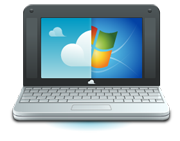
Another operating system comes out from the era of open source, they are making things so faster that closed source system must think about their tech shares and market. However, we can say that open source systems are just making things so portable and light version, so that people can use them so easily and so comfortably………
They are making products specific, like if anyone is so used to with their social networking just give those things near to their hands, and just installed those required softwares or better to say packages what are needed to write things, edit, manage, undo and of course the media drivers…..because without them a PC is nothing………
So they make another specific, strong, portable and comfortable Operating system specially for netbook or laptop users, JoliCloud (Cloud with joy). JoliCloud is the OS which ensures you the most important point for the users (Novice and for the pro’s also) that, it can be easily installed side by side with your Windows OS. Maximum novice users like me made a mess while we install linux versions in our desktop PC’s with windows xp, vista or 7 by it’s side. But hey! No need to worry again while you install linux OS (Ubuntu, Fedora, Mandriva, CentOS, Redhat, Scientific Linux, SUSE and more open source OS). There’s a must say that, we make error in the partitioning sector while system wants its place in the hard disk. But now listen joyfully- Worlds 1st OS (JoliCloud) comes with an .exe file whose size is merely (16.00 MB). You just need to download this file from http://www.jolicloud.com from this website. And execute it from your existing Windows OS. It will download the whole OS with in 45 minutes and gives you the simple instructions in a simple coffee time manner. Jolicloud comes with an USB creator also. First jolicloud 1.0 comes up with those users who uses netbook because the display size of a netbook is max 11”. It supports that much size. Another cause for bringing it is netbook users maximum uses the word processor for documents, listening music, watching movies doing light works and especially they use internet on the move so they need all the social networking sites and that’s why it comes with a logical chip which connects to the internet very speedily.
So in all netbook users can use this OS for real fun and some serious work with funny environment. Oh I forgot to tell you that jolicloud doesn’t give the professional look like Microsoft windows neither the look of Ubuntu Lucid Lynx. It’s funny, very colorful, soothing atmosphere. Twitter, facebook, Gmail, LinkedIn, Picasa etc in your punch. Punch those applications like never before. It’s graphics is beautiful. Appearance is fantastic, folders, icons, starting music these common features are eye and ear catching. Later jolicloud comes with an update which gives you desktop version which can be run from our home PC. For that you just install the OS , connect to the internet and make an update of your OS. That’s all. You can switch between versions. Working with jolicloud is a real fun with some practical work. A lightweight OS which takes you through a simple installation instructions which will be given below :-
1. Download Jolicloud Express
You can download Jolicloud Express here: www.jolicloud.com/download.
Here is the MD5 sum of the Jolicloud Express file: MD5 (JolicloudInstaller.exe) = a75b8e4f137d466dbee25c1b8f4d4779
Once you have downloaded the JolicloudInstaller.exe file, double-click on the icon to extract the file.
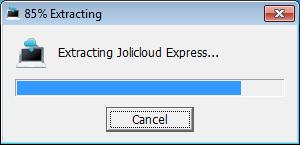
On the first welcome screen, click on ‘Get Started’.
2. Create your computer login
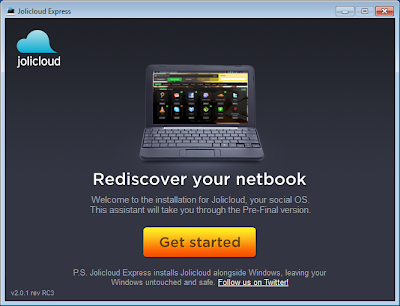
3. Manage your set up configuration
By default, Jolicloud Express chooses the set up configuration that would give you the best experience: It picks the disk you are currently using, and allocates half of the available space on that disk for Jolicloud. It also chooses your existing system language.
If you are happy with the default configuration, click ‘Next’. If you want to make changes to the configuration, click ‘Change’.
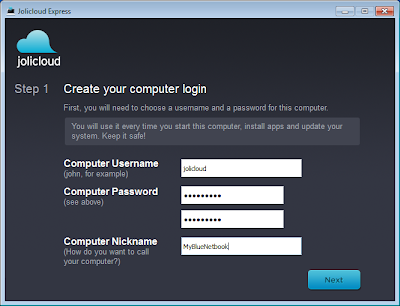
Change options
By clicking on the 'Change' button, a new window pops up where you can change your setup. You can select another disk to install Jolicloud, and decide how much disk space you want to use for Jolicloud, from 4GB to almost all the free available space on your hard drive. Your choice will not impact performance, but how many apps and files you can store locally. You can also select a different language to use on Jolicloud.
Click ‘Save’ when you are done.
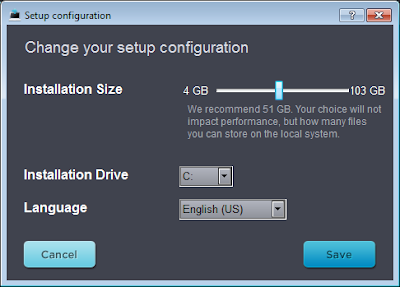
4. Prepare for install
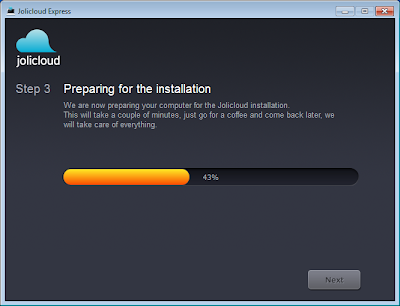
Once the preparation is complete, click ‘Restart now’.
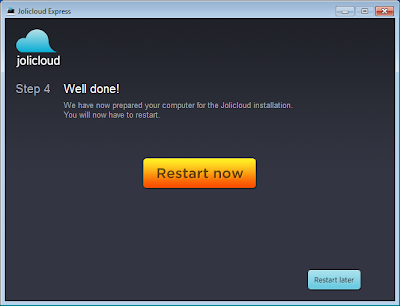
5. Install Jolicloud
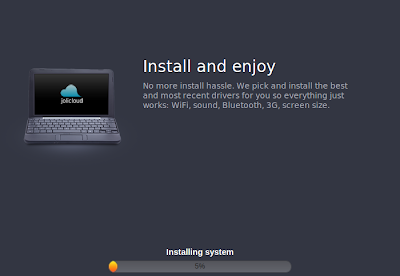
6. Activate your Jolicloud account

Make sure your netbook is connected to the Internet
You will need to connect your netbook to the Internet to make the most of Jolicloud.
When your netbook is not connected to the Internet, the icons at the top right of your screen will look like this:

To connect your netbook to the Internet, click on the network icon.
Choose the wired or wireless network you want to connect to from the options in the roll down menu.
A window pops up indicating which network your netbook is connected to.
When your netbook is connected to the Internet, the icon will indicate that the WiFi connection is on:

2 - Click the ‘Get Started’ icon on the launcher.
3 - Enter your username and password.

4 - Register your netbook and pick a name for it.

Congratulations! Your netbook is now connected to your Jolicloud account.
7. How to install applications
Make sure your netbook is connected to the Internet.
1 - Click on the blue Jolicloud icon (in the central part of the launcher, or at the top right corner of your screen).
You will see a Welcome screen with four main tabs: Dashboard, Applications, Settings and Lab, and a yellow box on the top right side ‘Search friends and apps’.
2 - Click the Applications tab. You can chose to browse applications by category or to see all of them click ‘All’.
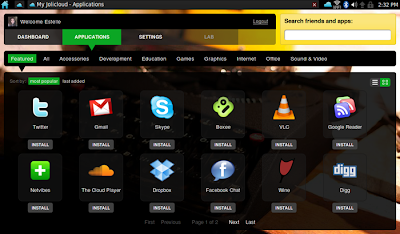
3 - To see a short description of the application simply click on an application icon.
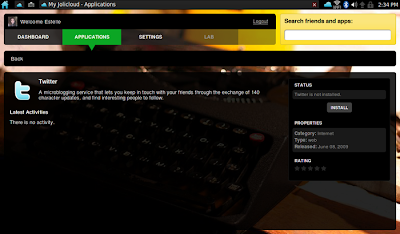
4 - To install an application, click on the ‘INSTALL’ button below the icon.
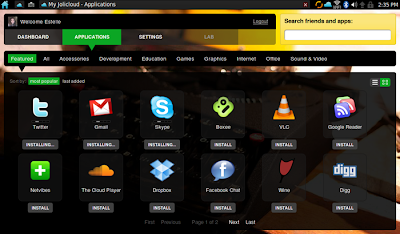
To install several applications at the same time, click on the ‘INSTALL’ button below each of the applications icons.
5 - Once you have installed applications, you will be able to see them in the launcher: to go back to your Jolicloud launcher, click on the blue house icon at the top left corner of your screen.
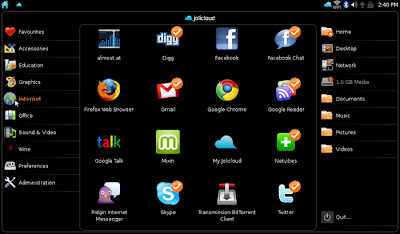
6 - Browse the applications you have installed using the category menu on the left side of the screen.
7 - To launch an application click on the application icon in the central area of the screen.
8. Update your system
Make sure your netbook is connected to the Internet.
With Jolicloud, updates come really easy. Check for and run new updates in: Jolicloud > Dashboard > Updates.
If there are updates available for your machine then you should always run them as soon as you can. That will allow you to always be on top and benefit from our latest improvements.
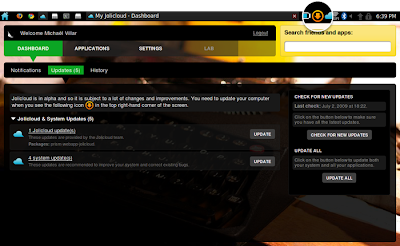
9. How to find and follow Jolicloud users
Make sure your netbook is connected to the Internet.
1 - Click on the blue Jolicloud icon (in the central part of the launcher, or at the top left corner of your screen).
You will see a Welcome screen with four main tabs: Dashboard, Applications, Settings and Lab, and a yellow box on the top right side ‘Search friends and apps'.
2 - Use ‘Search friends and apps’ to find who you are looking for.

3 - Click on the user name to access their profile. Click on the ‘Follow’ button under ‘Status’ on the right side of your screen.
4 - You are now able to follow the activity of the people you follow under Dashboard > Notifications.
3 - Click on the user name to access their profile. Click on the ‘Follow’ button under ‘Status’ on the right side of your screen.
4 - You are now able to follow the activity of the people you follow under Dashboard > Notifications.
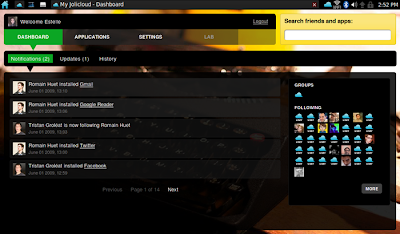
5 - When you receive new notifications, you will see the Jolicloud icon in orange with a number underneath. It will look like this:

Click on the orange icon to access your notifications.
How to uninstall Jolicloud Express
1 - Select Windows at boot.
2 - Once Windows is launched, go to ‘Control Panel’ > ‘Programs’ > ‘Programs and features’. Select ‘Jolicloud’ to uninstall it.
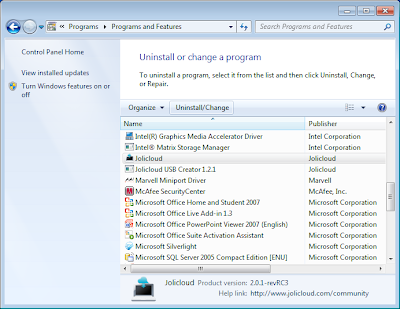
Your system extracts the Jolicloud Express uninstaller.
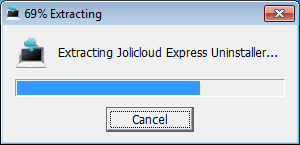
3 - Confirm that you want to uninstall Jolicloud.
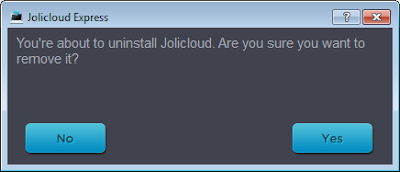
4 - Click ‘OK’.
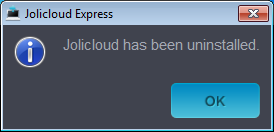
Jolicloud has now been uninstalled from your computer.
Sunday, August 8, 2010
The New Company Comes in Indian Market with It's ravishing product, new link between two generations: Olive Pad
Olive Pad is the new one which comes in our way after the revolution of i-Pad of Apple. i-Pad which made an entry this year with a lot of features connected with it. It enters rapidly in Britain, Australia, Enhland but when it will come to India? We were waiting for the launch of i-Pad. In that mean time Olive the company from nowere just enters in the market with it's product looks like an i-Pad. They called it “Olive Pad”. Olive is a company which lately comes to India for the selling of Mobile Phones but now it got the chance to capture peoples mind with it's one and only Olive Pad.

Olive Pad
Olive Pad is such a gadget which has a stunning WVGA (Wide Video Graphics Array) of 7'' still it has a capability of making calls like mobile phones. Not only that it added this with a Android OS of Google and with 3G technology. You will be able to do during with it's 3G as well as 2G technology, it has GPS System, it has a support Qualcom MSM 7227 Chipset and has 512MB RAM and a internal Spcae of (512+512)MB, It could be expandable upto 32 GB with normal card slot. It has a 3.5mm Jack for listening music and obvoiusly it supprts flash in it which is a disadvantage of i-Pad. It has a 802.11g i.e Wirless or Wi-Fi, G-Sensor supports it for various call functions(in Progress). It has a talk time of 1200 mins when it is in GSM and 480 mins when the mode is in WCDMA (Wideband Code Division Multiple Access). It supprts all the requirements what a regular user requies. What is very interesting is that olive pad has a li-on battery and 3240mAh, and it has all the so called mobile phone features like can store sms upto 500 and can store 2000 phonebook entries, vibration, speaker phone, calender, calculator, world clock etc. But i-Pad is one step further because of it's technologies like Retina Display, it has a app store and it is the best when you read e-books and best site to surf the web, i-Pad doesn't have a call capability though it has a SIM card tray and it supports the GSM and WCDMA bands but most unwanted words” For Data Only” means you can recieve text files, html files, but not the voice.
One disadvantage in Olive Pad is that it supports 802.11b/g but not the other versions like a/n.Whether i-Pad has. The i-Pad is for those ones who want it only for specific reason(ebook reading, connecting net and surf, Swtich on TV while sitting inside bathroom). But Olive Pad is for those people who want it big with some of the features what is possible to have mobile and can use like a mobile phone. Olive Pad has done a great job to those people who want to share their picture while taken means, it has a 3 Mega Pixel camera with 4x auto focus at the back and a front facing VGA camera for Video Conferencing in 3G. It has Android OS which gives it another high with the android market while competing with i-Pad (Apple App Store). So, Olive Pad fills the gap between a smartphone and i-Pad.
Last thing what we want to know is that what's the price man?
So, the price could pinch your pocket and can burn a hole in it but if you comapre price of the i-Pad then it's ok. The standard price of Olive Pad is Rs. 20,000/--25,000/-. but it's now on the table that what could be the price of it? May be it will shift to 16,000/--18,000/-. But when can't say.
Anyways, People who want to make call, take pictures, listening to music and fond of social networking just swipe your fingers across this 3G enabled India's First Android Tablet: Olive Pad.
So the chain coiuld be
Smartphone ----------> Olive Pad ---------> i-Pad -----------> Laptop
The specifications of Olive Pad is given below:
OlivePad VT100 Full Specifications
GSM 850/900/1800/2100
WCDMA 900/1900/2100
Chipset Qualcomm MSM7227
GPRS Class 12
Dimensions 179.4(H) * 110(W) * 11.5(T)
Screen 7 inch TFT Capactitive Touchscreen
Display 800×480 WVGA Display
Internal Memory 512 MB+ 512 MB
Memory Card support upto 32 GB
Phonebook memory 2000
SMS memory 500
3.5 mm audio jack yes
Charging mini USB
Battery Li-Po
Capacity 3240mAh
Standby time GSM:400h WCDMA : 550h
Talktime GSM :1200mins WCDMA : 480 mins
Camera 3 MP Autofocus 4X zoom
Audio formats supported MIDI, MP3, AMR, AAC AAC+
Speaker Dual
Video Streaming yes
Video Formats 3GP
Bluetooth v2, AD2P
WiFi 802.11 b/g
Other Applications it has inbuilt:
Compass
G-sensor
Ambient Light sensor
Email Pull email
MMS, WAP
GPS
PC-sync
Speaker
Vibration
Stopwatch
calendar
calculator
world clock

Olive Pad
Olive Pad is such a gadget which has a stunning WVGA (Wide Video Graphics Array) of 7'' still it has a capability of making calls like mobile phones. Not only that it added this with a Android OS of Google and with 3G technology. You will be able to do during with it's 3G as well as 2G technology, it has GPS System, it has a support Qualcom MSM 7227 Chipset and has 512MB RAM and a internal Spcae of (512+512)MB, It could be expandable upto 32 GB with normal card slot. It has a 3.5mm Jack for listening music and obvoiusly it supprts flash in it which is a disadvantage of i-Pad. It has a 802.11g i.e Wirless or Wi-Fi, G-Sensor supports it for various call functions(in Progress). It has a talk time of 1200 mins when it is in GSM and 480 mins when the mode is in WCDMA (Wideband Code Division Multiple Access). It supprts all the requirements what a regular user requies. What is very interesting is that olive pad has a li-on battery and 3240mAh, and it has all the so called mobile phone features like can store sms upto 500 and can store 2000 phonebook entries, vibration, speaker phone, calender, calculator, world clock etc. But i-Pad is one step further because of it's technologies like Retina Display, it has a app store and it is the best when you read e-books and best site to surf the web, i-Pad doesn't have a call capability though it has a SIM card tray and it supports the GSM and WCDMA bands but most unwanted words” For Data Only” means you can recieve text files, html files, but not the voice.
One disadvantage in Olive Pad is that it supports 802.11b/g but not the other versions like a/n.Whether i-Pad has. The i-Pad is for those ones who want it only for specific reason(ebook reading, connecting net and surf, Swtich on TV while sitting inside bathroom). But Olive Pad is for those people who want it big with some of the features what is possible to have mobile and can use like a mobile phone. Olive Pad has done a great job to those people who want to share their picture while taken means, it has a 3 Mega Pixel camera with 4x auto focus at the back and a front facing VGA camera for Video Conferencing in 3G. It has Android OS which gives it another high with the android market while competing with i-Pad (Apple App Store). So, Olive Pad fills the gap between a smartphone and i-Pad.
Last thing what we want to know is that what's the price man?
So, the price could pinch your pocket and can burn a hole in it but if you comapre price of the i-Pad then it's ok. The standard price of Olive Pad is Rs. 20,000/--25,000/-. but it's now on the table that what could be the price of it? May be it will shift to 16,000/--18,000/-. But when can't say.
Anyways, People who want to make call, take pictures, listening to music and fond of social networking just swipe your fingers across this 3G enabled India's First Android Tablet: Olive Pad.
So the chain coiuld be
Smartphone ----------> Olive Pad ---------> i-Pad -----------> Laptop
The specifications of Olive Pad is given below:
OlivePad VT100 Full Specifications
GSM 850/900/1800/2100
WCDMA 900/1900/2100
Chipset Qualcomm MSM7227
GPRS Class 12
Dimensions 179.4(H) * 110(W) * 11.5(T)
Screen 7 inch TFT Capactitive Touchscreen
Display 800×480 WVGA Display
Internal Memory 512 MB+ 512 MB
Memory Card support upto 32 GB
Phonebook memory 2000
SMS memory 500
3.5 mm audio jack yes
Charging mini USB
Battery Li-Po
Capacity 3240mAh
Standby time GSM:400h WCDMA : 550h
Talktime GSM :1200mins WCDMA : 480 mins
Camera 3 MP Autofocus 4X zoom
Audio formats supported MIDI, MP3, AMR, AAC AAC+
Speaker Dual
Video Streaming yes
Video Formats 3GP
Bluetooth v2, AD2P
WiFi 802.11 b/g
Other Applications it has inbuilt:
Compass
G-sensor
Ambient Light sensor
Email Pull email
MMS, WAP
GPS
PC-sync
Speaker
Vibration
Stopwatch
calendar
calculator
world clock
Sunday, July 25, 2010
The old technology but not used everywhere, we often have heard about: VoIP (Voice Over internet Protocol)
The term VoIP means Voice over internet protocol. This technology is used for the transmission of voice over internet that means it will use the so called broadband service in your telephone. Ethernet or any kind of PSTN could be used for this VoIP. The names of this VoIP is: IP telephony, Broadband Telephony, Intenet Telephony, Broadband Phone, Voice over Broadband(VoBB) etc.
This process includes some steps that we dont know about and how mere a telephone could be connected with the ethernet or internet and communication process goes on. Better to say that VoIP uses PSTN as its path and moves on. In a regular telephone when we speak that speeches are carried out by dedicated telephone lines and those signals are analog signals and reaches to recieving end as an analog signal. No conversion happens at the time transmission. But in this telephony conversion happens when the ssignal is transmitting. When speaker speaks at that time the “SPEAK” (Signal) converted to digital signal and those signals forms a packet which is divided in several packets and then transmitted through the PSTN to the reciever. The signal got also compressed and sent it over the IP protocol and the whole process gets reversed at the recieving end.
Now people must think that as it is a VoIP so does it own a IP address dedicated for this VoIP?
Or how the process goes on as it is said PSTN (Public Switched Telephone Network) as its path?
Well, for those answers I must give some information about Switching. That is in a plain networking switching refers to a communication between two or more computers but dedicated path.Here's also the same route is adopted i.e. Dedicated lines between talkers and there are 2 satges with which they can setup (Set-Up Phase) their lines and talk over it and at the end it will execute the Tear Down phase. And as well as when the signal got transformed to digital signal, it must have to use some audio codec to transform, it has a variety of codecs in audio signals and that varies between the several implementations of VoIP. And for the first question that does it need any IP Address? Well, no we dont need that beacause, it should be connected to the computer and specially it is not supporting mobility.
Another point I must include that VoIP supports session protocol which means it does senses the line continuously for its activieness but when it sense that the line is idle for some long time it will automatically cut the line off. We need to reconnect the line to move on. For the connection you need to have three mandatory thing:
1. ATA (Analog Telephone Adapter): The work of that adapter is to connect two lines one is analog phone line and another is for the computer or DSL Broadband line and the adopter must be at a static location. Both lines performs when we talk. eg. Vonage, AT & T CallVantage are the phones which comes free with the service. Sometimes it has some softwares to setup the phone but anyhow those software setups are very easy and straight forward.
2. Dedicated VoIP Phones: The specialized look of the the phone is nothing but ut has a small screen at buttons that to cradle. But instead of RJ-11 connectors the phone has RJ-45 Connectors to connect with the broadband. Ip phones can be directly connected to the router and it has all ecessary softwares and hardwares in it onboard. It needs to be paid to get the service from VoIP providers.

VoIP PHONES
3. Computer to Computer: The certainly most easiest way to make a call for a long distance you need to have computer, a software, Internet Connection, Sound Card that's it. Companys even dont charge of any kind for a the call except the monthly fee.

VoIP DIAGRAM
Using these stuffs you can do VoIP calls but at a lower cost (if needed). There is a lot of difference between normal analog telephone and a VoIP telephone. We are talking a lot about this but we haven't mention yet that why should we use VoIP telepehones? We should use this service because, the cost of time depends a lot. Now-a-days human being gives more cost for time than any item. This leads us to a new technology VoIP. In a normal telephone it requires almost a lot of time whereas in VoIP the time becomes less to talk.
Lets give an example, suppose a man talks to a man for 10 minutes. But think the call makes a route from New York to Los Angeles means a 3000 Mile. So in a normal telephone what happens when some body makes a call that call goes through a set of switches which is scattered throughout the city. In this case it happens so and it travels a 3000 mile copper wire and holds the line for 10 minutes. Think how much cost we are paying for a mere 10 min call. Why does it take 10mins? Bacause the line is made of copper and less efficient to carry out the signals and data compression not supported by this regular telephone system. But if the conversation needs 10mins in a regular line it will take only 3.5 mins in a VoIP line means, in internet telephony.
Save time to Save Money.
On the other hand as VoIP uses packet switching which gives us the provision of sending signals or for communication a little cost for a little time. For a 10mins phone call we consumed 10 full minutes for transmission timeat a cost of 128Kbps. But with VoIP that same call takes only 3.5 minutes of transmission time at a cost of 64Kbps, leaving another 64Kbps free for that 3.5 minutes plus another 128 Kbps for the remaining 6.5 minutes. That means easily another 3 or 4 phone calls can be placed using the same conventional line.
Some steps of this VoIP communication is:
1. reciever is picked up and which sends a signal to ATA (Analog Telephone Adapter)
2. the adapter recieves a signal and sends a dial tone to sender. In this case it simultaneously makes you know that you are connected to the internet.
3. Phone number is dialled and that number goes to the VoIP company's call processor and before that it is being digitized by ATA adapter.
4. The processor checks its validity and makes the call after mapping it and translated it into a IP address.
5. The soft switch (the software that comes with the adapter and handset) connects two devices on either end of the call. On the other end the signal goes to receiver's ATA telling it to ask the connected phone to ring.
6. Once riciever picks up the phone a session is established between them and packets are sent via the path. In the middle of that call the call is handelled by the internet infrastructure just as a email or a webpage. Both the sender and reciever should use the same protocolto communicate.
7. When the call is on the go the packets are being transmitted by the ATA to analog audio signal at each end at each transmission.
8. At the end of the call the session has ended the switch is closed.
This technology is such a boost to the huge communication system still it is not available for some possible reasons like: viruses, hacking, NANP calls, and most significant drawback is power means, if power goes out the phone dies immediately.
We hope that these drawbacks will be filled soon with the solutions and will enter our life and will save our money that is “TIME”................. :) :) :)
This process includes some steps that we dont know about and how mere a telephone could be connected with the ethernet or internet and communication process goes on. Better to say that VoIP uses PSTN as its path and moves on. In a regular telephone when we speak that speeches are carried out by dedicated telephone lines and those signals are analog signals and reaches to recieving end as an analog signal. No conversion happens at the time transmission. But in this telephony conversion happens when the ssignal is transmitting. When speaker speaks at that time the “SPEAK” (Signal) converted to digital signal and those signals forms a packet which is divided in several packets and then transmitted through the PSTN to the reciever. The signal got also compressed and sent it over the IP protocol and the whole process gets reversed at the recieving end.
Now people must think that as it is a VoIP so does it own a IP address dedicated for this VoIP?
Or how the process goes on as it is said PSTN (Public Switched Telephone Network) as its path?
Well, for those answers I must give some information about Switching. That is in a plain networking switching refers to a communication between two or more computers but dedicated path.Here's also the same route is adopted i.e. Dedicated lines between talkers and there are 2 satges with which they can setup (Set-Up Phase) their lines and talk over it and at the end it will execute the Tear Down phase. And as well as when the signal got transformed to digital signal, it must have to use some audio codec to transform, it has a variety of codecs in audio signals and that varies between the several implementations of VoIP. And for the first question that does it need any IP Address? Well, no we dont need that beacause, it should be connected to the computer and specially it is not supporting mobility.
Another point I must include that VoIP supports session protocol which means it does senses the line continuously for its activieness but when it sense that the line is idle for some long time it will automatically cut the line off. We need to reconnect the line to move on. For the connection you need to have three mandatory thing:
1. ATA (Analog Telephone Adapter): The work of that adapter is to connect two lines one is analog phone line and another is for the computer or DSL Broadband line and the adopter must be at a static location. Both lines performs when we talk. eg. Vonage, AT & T CallVantage are the phones which comes free with the service. Sometimes it has some softwares to setup the phone but anyhow those software setups are very easy and straight forward.
2. Dedicated VoIP Phones: The specialized look of the the phone is nothing but ut has a small screen at buttons that to cradle. But instead of RJ-11 connectors the phone has RJ-45 Connectors to connect with the broadband. Ip phones can be directly connected to the router and it has all ecessary softwares and hardwares in it onboard. It needs to be paid to get the service from VoIP providers.

VoIP PHONES
3. Computer to Computer: The certainly most easiest way to make a call for a long distance you need to have computer, a software, Internet Connection, Sound Card that's it. Companys even dont charge of any kind for a the call except the monthly fee.

VoIP DIAGRAM
Using these stuffs you can do VoIP calls but at a lower cost (if needed). There is a lot of difference between normal analog telephone and a VoIP telephone. We are talking a lot about this but we haven't mention yet that why should we use VoIP telepehones? We should use this service because, the cost of time depends a lot. Now-a-days human being gives more cost for time than any item. This leads us to a new technology VoIP. In a normal telephone it requires almost a lot of time whereas in VoIP the time becomes less to talk.
Lets give an example, suppose a man talks to a man for 10 minutes. But think the call makes a route from New York to Los Angeles means a 3000 Mile. So in a normal telephone what happens when some body makes a call that call goes through a set of switches which is scattered throughout the city. In this case it happens so and it travels a 3000 mile copper wire and holds the line for 10 minutes. Think how much cost we are paying for a mere 10 min call. Why does it take 10mins? Bacause the line is made of copper and less efficient to carry out the signals and data compression not supported by this regular telephone system. But if the conversation needs 10mins in a regular line it will take only 3.5 mins in a VoIP line means, in internet telephony.
Save time to Save Money.
On the other hand as VoIP uses packet switching which gives us the provision of sending signals or for communication a little cost for a little time. For a 10mins phone call we consumed 10 full minutes for transmission timeat a cost of 128Kbps. But with VoIP that same call takes only 3.5 minutes of transmission time at a cost of 64Kbps, leaving another 64Kbps free for that 3.5 minutes plus another 128 Kbps for the remaining 6.5 minutes. That means easily another 3 or 4 phone calls can be placed using the same conventional line.
Some steps of this VoIP communication is:
1. reciever is picked up and which sends a signal to ATA (Analog Telephone Adapter)
2. the adapter recieves a signal and sends a dial tone to sender. In this case it simultaneously makes you know that you are connected to the internet.
3. Phone number is dialled and that number goes to the VoIP company's call processor and before that it is being digitized by ATA adapter.
4. The processor checks its validity and makes the call after mapping it and translated it into a IP address.
5. The soft switch (the software that comes with the adapter and handset) connects two devices on either end of the call. On the other end the signal goes to receiver's ATA telling it to ask the connected phone to ring.
6. Once riciever picks up the phone a session is established between them and packets are sent via the path. In the middle of that call the call is handelled by the internet infrastructure just as a email or a webpage. Both the sender and reciever should use the same protocolto communicate.
7. When the call is on the go the packets are being transmitted by the ATA to analog audio signal at each end at each transmission.
8. At the end of the call the session has ended the switch is closed.
This technology is such a boost to the huge communication system still it is not available for some possible reasons like: viruses, hacking, NANP calls, and most significant drawback is power means, if power goes out the phone dies immediately.
We hope that these drawbacks will be filled soon with the solutions and will enter our life and will save our money that is “TIME”................. :) :) :)
Saturday, July 10, 2010
Novice Phone Lovers it’s for you: iOS 4

iOS (iPhone Operating System), is the software that is installed in iPhone, iPod Touch, and now recently hyped material in the world of tablet computer yes! The iPad. For small information I want my readers to know about the OS. Its first revealed in January 9, 2007. And released in June in that year. This is a derivation of MAC OS X, which is a OS of notebooks and Macbook mini, MacBook etc. It shares the Darwin foundation, and is therefore looks like a Unix based OS by nature. This name first came in the eyes of few people who visited an Expo at Macworld Conference & Expo. That year Apple named that OS is “iPhone uses OS X”. After that it uses it in its iPhone first generation, and get surprisingly hype and it was sold more than 2 million. After seeing this in a press conference Mr. Steve Jobs announced that its modifying version is coming up and this OS doesn’t need any third-party hardware support. It will run independently. It was announced also that Apple is making a SDK for this OS support in iPhone. After the rapid development in OS it released this OS in iPod Touch that has a capability of the iPhone without the feature of Video Phone hardware.
Apple has its own way for representing things and for that on January 27,2010 Apple announced the release of iPad which has a broad Display than iPhone and iPod Touch. With a bumper sale of 1 million product in 1st month Apple gets the way to go through and later it licecse the name iOS from Cisco Inc. Apple has 225,000 applications in its app store for this OS. Which still doesn’t support any third-party hardware. iOS has four layers in its architecture :
1. Abstraction Layer (helps the OS to hide the process of binding of the code and data)
2. Core Services Layer (it helps the OS to run the services run by itself)
3. Media Layer (Helps to run the multimedia features in its body)
4. Cocoa Touch Layer (Helps the user by providing the multi touch gestures in the display)
So, we have now know much about iOS that is now developed that the final (not last) version is running all over that one: iOS 4. This makes some additions in Apple made iPhone 4. Previous versions of iPhone were much boring where as now those stuffs building an interest in peoples face. As it added some features but still lagging behind somewhere. Its like this:
1. Multi-tasking:-
the all new iOS 4 supports finally multi-tasking, i.e. much needed for a user.first generation versions are not compatible with this feature not will be. Now user can jump into another app while doing action in other app. Need not to open it again and again.
iPad also supports multi-tasking.

2. iAd (Revolutionising the world of Mobile Advertising) :-
Well it’s all started with buying a company (Quattro) of mobile advertising last year. From there the development starts and new feature added by Apple in iPhone. It is a launching iAd kind of application to help to change the way of mobile advertising goes on. Suppose you are general movie show time app and suddenly you see that there is a toy stroy is trying to poking his head out the bottom. Peel the bottom layer and you get an application with in an application. It stands for suppose you are in a website where you get a short ad of going to get to a new website. That’s it.

3. Gaming Center:-
Apple is supporting the games also where it launched a social network where you can play games as well as making partners in same kind of games, if you are not getting a partner this app will find a partner for you. Isn’t it cool!

4. Folders for your icons:-
are you getting bored with the so called icons on your home screen? Then just feel free because Apple gives you the freedom of choosing the icons of your folders. And can name them whatever you want but can’t name them like”System32” it will not represent the OS sub folder. And when you create a folder you can sum up all the apps as you choose and access them as you want.

5. Unified the inbox:-
the iPhone has evolved slowly-somebody said. Because, Apple makes an update is that you don’t have to jump in or out again and again for seeing your mail. Apple made it unified all into one place-thankfully coinciding the announcement that users can have more than one exchange account on it’s devices. Just like gmail and facebook and orkut you can work in your inbox and as well as you can with your friends as all the conversations are threaded. Attachments can be done in your emails.

6. iBooks comes all the way:-
The all new element that is added in iPad and iPhone is iBook where you will be able to download the books and read them. Better you say that it is an app for reading PDFs’. Apple has a rival: Adobe. So it will never use Acrobat Reader in Steve Jobs iPad. Everything has an app in the way PDFs’ and e-books have.

7. No flash:-
Mr. Steve Jobs think that flash has several disadvantages which is not implacable in his device so he is strongly denied to Flash. So, its a bad news for Farmville, Fishville, cafe world players. Maybe there will be some app called “iflash” in near future. Anyways development is on the way.
So still apple lags behind in some fields. iPhone 4 will be a worth of buying with certain price. iPad is already sold so much. 3 million iPads in last 3 months. Not a joke!!!!! So, here we can get an all over idea that Apple is trying tomake its own house with it’s own furniture and carpets. Let’s see when the whole world will see an “i”. This is all about iOS 4 which gives you a new feeling of handling your iPhone r tablet Computer iPad. Hope there will be more updates in iOS 4 and will be launched soooooooooooooooooonnnnn...........
Monday, July 5, 2010
Technology won’t end, not for a while....So it’s taking on our skin now: SKINPUT
As I told you pals in my previous blog that Chris Harrison is rising star of this battle field. So again he proved this. He concluded the study of Scratch Input but as I told that research is yet not finished, for that one another technology comes up in our techno zone that comprises with Scratch input as well as a new one i.e. SKINPUT.
In this research it’s said that the easiest device to get in touch with almost everyone and to do our job what is we do with mobile phones. It’s believed that most of us don’t want to carry more things with us. So for that, we need to get those things which we don’t have to hold, such as bands which we can wear but we need not to worry about that, oh! Where is it? Where I have left it? Blah blah blah................ in that case we forget or better say we overlooked that surface where we can apply all the inputs and can do our work, can carry out every small functions, can implement the technology scratch input. That overlooked surface, which happens to travel with us all time, is: OUR SKIN. This can be used as an input, means, a kind of ray will be in your hand which has some buttons of your mobile phones, the mobile phone is chosen because we have the surface area not so broad but is very good for placing any buttons or numbers.

Numbers are shown palm

Forehand is being used as an Input Surface
Now let’s take a look in the sensors which actually senses about the taps or drags done by our fingers. Sensors are built with very much difficulty because; we don’t have those sensors which can measure the wave passes in the bones of human body. There are so many bio-sensors like: EEG(electro encephalography), functional near infrared spectroscopy(fINAR) etc. fINR is used by HCI(Human-Computer Interaction Institute). There are other heart beat measuring equipments, other brain signal catching technologies. But there is no technology which can measure the consciousness of mind, concentration power of our mind. Here we need those sensors which can measure the wave that passes by the bones. Researchers got a bit deeper for that need; they got electromyography (EMG). But this one didn’t work also. And there after two new sensors comes up but they are also not capable of taking the waves from bones. Finally, bone conduction microphones and headphones- now common consumer technologies-represents an addition bio-sensing technology that is relevant to the present work. Now with the immense help of this technology we entered the new threshold of touch. Here skin is used as an input surface area. For an example forearm is used to represent this technology.

SENSOR

SENSORS FROM INSIDE
Sensing
When we tap our forearm with a finger tip a signal transverse the forearm and it propagates the wave. That wave is technically measured with the sensors (modified from bone conduction microphones and headphones) and it determines where from the tap comes from and then it catches the intersection point from where the signal generates and it does its action according to the configured commands. Those sensors are then modified again to catch the low frequency signals (below the human voice) for that cantilevered sensors comes up. It is so small and able to catch the waves through bone. Now to place those sensors an armband is configured. It’s so comfortable with the arm and easy to remove also. Now after wearing the armband it becomes partly mobile. Now we can do this experiment a ray falls upon our forearm, it falls with some buttons and numbers, we tap one of them and it transverse a signal through the bone and the processing is done according to the wave. So ,in this way we can operate our mobile phone. But here some questions remains in our mind that where are the speakers? Where are microphones and all that?
Idea
However, we can easily say that this research brings us new technology, can be used with our skin. This one gets so closer. We are technology prone human beings now days. In our daily life we never put a step without any gadget but this is extreme. Now it reaches to our skin also. Its now time to see that what comes next?
All the details came from Chris Harrison official site: http://www.chrisharrison.net/projects/skinput
The demonstration video of this project is here: http://www.youtube.com/watch?v=g3XPUdW9Ryg&feature=player_embedded
I f you want to download the research paper then go to the above site and unveil the next generation of Technology. All credit goes to Chris Harrison for all his upcoming projects and researches.
In this research it’s said that the easiest device to get in touch with almost everyone and to do our job what is we do with mobile phones. It’s believed that most of us don’t want to carry more things with us. So for that, we need to get those things which we don’t have to hold, such as bands which we can wear but we need not to worry about that, oh! Where is it? Where I have left it? Blah blah blah................ in that case we forget or better say we overlooked that surface where we can apply all the inputs and can do our work, can carry out every small functions, can implement the technology scratch input. That overlooked surface, which happens to travel with us all time, is: OUR SKIN. This can be used as an input, means, a kind of ray will be in your hand which has some buttons of your mobile phones, the mobile phone is chosen because we have the surface area not so broad but is very good for placing any buttons or numbers.

Numbers are shown palm

Forehand is being used as an Input Surface
Now let’s take a look in the sensors which actually senses about the taps or drags done by our fingers. Sensors are built with very much difficulty because; we don’t have those sensors which can measure the wave passes in the bones of human body. There are so many bio-sensors like: EEG(electro encephalography), functional near infrared spectroscopy(fINAR) etc. fINR is used by HCI(Human-Computer Interaction Institute). There are other heart beat measuring equipments, other brain signal catching technologies. But there is no technology which can measure the consciousness of mind, concentration power of our mind. Here we need those sensors which can measure the wave that passes by the bones. Researchers got a bit deeper for that need; they got electromyography (EMG). But this one didn’t work also. And there after two new sensors comes up but they are also not capable of taking the waves from bones. Finally, bone conduction microphones and headphones- now common consumer technologies-represents an addition bio-sensing technology that is relevant to the present work. Now with the immense help of this technology we entered the new threshold of touch. Here skin is used as an input surface area. For an example forearm is used to represent this technology.

SENSOR

SENSORS FROM INSIDE
Sensing
When we tap our forearm with a finger tip a signal transverse the forearm and it propagates the wave. That wave is technically measured with the sensors (modified from bone conduction microphones and headphones) and it determines where from the tap comes from and then it catches the intersection point from where the signal generates and it does its action according to the configured commands. Those sensors are then modified again to catch the low frequency signals (below the human voice) for that cantilevered sensors comes up. It is so small and able to catch the waves through bone. Now to place those sensors an armband is configured. It’s so comfortable with the arm and easy to remove also. Now after wearing the armband it becomes partly mobile. Now we can do this experiment a ray falls upon our forearm, it falls with some buttons and numbers, we tap one of them and it transverse a signal through the bone and the processing is done according to the wave. So ,in this way we can operate our mobile phone. But here some questions remains in our mind that where are the speakers? Where are microphones and all that?
Idea
However, we can easily say that this research brings us new technology, can be used with our skin. This one gets so closer. We are technology prone human beings now days. In our daily life we never put a step without any gadget but this is extreme. Now it reaches to our skin also. Its now time to see that what comes next?
All the details came from Chris Harrison official site: http://www.chrisharrison.net/projects/skinput
The demonstration video of this project is here: http://www.youtube.com/watch?v=g3XPUdW9Ryg&feature=player_embedded
I f you want to download the research paper then go to the above site and unveil the next generation of Technology. All credit goes to Chris Harrison for all his upcoming projects and researches.
Tuesday, June 22, 2010
Next technology is just a scratch: Scratch Input
There are several technologies running around us whom we have digested well in our daily life but there is something again which we never seen till now. It gives you a “Gift” with something that you never think of. Yes! It’s nothing but your one scratch on the surface (anything). With which you can control your calls in your mobile phones without touching your phone, i.e. simply amazing. You can say that it could be done also with Bluetooth device but friends it is completely different. Just with the help of a scratch on any surface you can control your calls. Provided your phone should be connected with the computer.
There’s sensor which looks like just a stethoscope head which is the key player here plays with all the input balls. This is built based on acoustic based input technique which that relies on the unique sound produced when we scratch on any surfaces. The word acoustic is- a sound wave that is defined by science, means when we produce any kind of sound either by tapping or by scratching or by any means that signal or that wave is a part definition of acoustic. This sensor catches the signal that comes from tapping or scratching any surface (wooden table, fabric, wall paint etc.) with finger nails. This sensor is easily coupled with those surfaces and programmed with some gestures of fingers that are compiled to some pre configured commands, which results what was programmed previously. Just like microprocessor nothing else.

The Sensor which catches the scratched input
Now if you drag your finger, that sensor can sense it and produce some wave which first caught by a computer and that gives the command to silent a mobile, to talk with someone, to make the phone in speaker. Steps are somewhat like this:
1. Drag finger across the surface in any gesture
2. Which caught at a distance by the sensor(connected with mobile phone, which is connected with the computer also)
3. Sensor is connected to the computer
4. Computer caught the wave and monitor the signal
5. Pre defined commands executes according to the gesture of the finger drag)

Sensor is placed on wall
So this is amazing without a touch screen technology that comes up recently in public’s hand. This sensor is built very small which can be placed in a mobile device also. The sensor turned into a large, unpowered and ad hoc finger input surfaces. It is concluded that users can perform six different kinds of scratch input gestures at about 90% accuracy with less than a five minutes of training and upon variety of surfaces. The sensor even senses a scratch at about a distance from 8 meter where the sensor is placed. The sound will be much clear as the scratch is done closer to the sensor. So even if you are sitting in a distance but the surface is same means, long wooden table, wall paint, fabric, etc. Then definitely you will be doing the same what you could do in near. But it can’t catch the signal if the sensor and the scratch input both are placed in different surface. It means surface matters the signal.

Computer catches the signal and getting the web
Who knows that this Scratch Input Technology becomes vaster? The study is now concluded, not the research. Just imagine what it could be afterwards, you can place your mobile phone in your desk and just with some small scratch input gestures you could do all the operations what is today done by holding the device and either by touching the screen or by tapping the buttons. In future days there is a plan to incorporate this technology in Windows Mobile Phones. Now, days are coming with such playful, funny and amazing devices that will need just a move in the air, nothing else.
This fabulous concept or you can say the marriage of simplicity and technology is developed by a person whose name I have heard just some days before, he is another rising sun in the battle field of techno stuffs. He is CHRIS HARRISON, researching in Carnegie Mellon University in 3rd year. He is also a Microsoft research Ph.D. so just think why Microsoft should worry about a 1% downfall in market shares ($219.58 billion). It knows what comes in future ............... and what “Gift” it’s going to give us.
To know about this stuff, folks visit here
http://www.chrisharrison.net/projects/scratchinput/index.html
Else follow this video: http://www.youtube.com/watch?v=2E8vsQB4pug&feature=player_embedded
There’s sensor which looks like just a stethoscope head which is the key player here plays with all the input balls. This is built based on acoustic based input technique which that relies on the unique sound produced when we scratch on any surfaces. The word acoustic is- a sound wave that is defined by science, means when we produce any kind of sound either by tapping or by scratching or by any means that signal or that wave is a part definition of acoustic. This sensor catches the signal that comes from tapping or scratching any surface (wooden table, fabric, wall paint etc.) with finger nails. This sensor is easily coupled with those surfaces and programmed with some gestures of fingers that are compiled to some pre configured commands, which results what was programmed previously. Just like microprocessor nothing else.

The Sensor which catches the scratched input
Now if you drag your finger, that sensor can sense it and produce some wave which first caught by a computer and that gives the command to silent a mobile, to talk with someone, to make the phone in speaker. Steps are somewhat like this:
1. Drag finger across the surface in any gesture
2. Which caught at a distance by the sensor(connected with mobile phone, which is connected with the computer also)
3. Sensor is connected to the computer
4. Computer caught the wave and monitor the signal
5. Pre defined commands executes according to the gesture of the finger drag)

Sensor is placed on wall
So this is amazing without a touch screen technology that comes up recently in public’s hand. This sensor is built very small which can be placed in a mobile device also. The sensor turned into a large, unpowered and ad hoc finger input surfaces. It is concluded that users can perform six different kinds of scratch input gestures at about 90% accuracy with less than a five minutes of training and upon variety of surfaces. The sensor even senses a scratch at about a distance from 8 meter where the sensor is placed. The sound will be much clear as the scratch is done closer to the sensor. So even if you are sitting in a distance but the surface is same means, long wooden table, wall paint, fabric, etc. Then definitely you will be doing the same what you could do in near. But it can’t catch the signal if the sensor and the scratch input both are placed in different surface. It means surface matters the signal.

Computer catches the signal and getting the web
Who knows that this Scratch Input Technology becomes vaster? The study is now concluded, not the research. Just imagine what it could be afterwards, you can place your mobile phone in your desk and just with some small scratch input gestures you could do all the operations what is today done by holding the device and either by touching the screen or by tapping the buttons. In future days there is a plan to incorporate this technology in Windows Mobile Phones. Now, days are coming with such playful, funny and amazing devices that will need just a move in the air, nothing else.
This fabulous concept or you can say the marriage of simplicity and technology is developed by a person whose name I have heard just some days before, he is another rising sun in the battle field of techno stuffs. He is CHRIS HARRISON, researching in Carnegie Mellon University in 3rd year. He is also a Microsoft research Ph.D. so just think why Microsoft should worry about a 1% downfall in market shares ($219.58 billion). It knows what comes in future ............... and what “Gift” it’s going to give us.
To know about this stuff, folks visit here
http://www.chrisharrison.net/projects/scratchinput/index.html
Else follow this video: http://www.youtube.com/watch?v=2E8vsQB4pug&feature=player_embedded
Sunday, June 20, 2010
Security of Apple: Mac OS X 10.5 Leopard unsafe but now Mac OS X 10.6.3 Snow Leopard safe

The Mac OS X is an open source operating system. i.e. its a free software version that comes under Apple Inc. Apple Mac book are the most demanded notebook in this market. Everybody has a fascination “if I would be having a Mac book I can play with it” this is the new generation wants-PLAY in a digital way. But they must be aware about the data and secret files they have in their machine, which they feel is important. Now as the Mac OS X is an open source OS that means it doesn’t get attacked with the viruses. For a small information I want to let my blog reader knows that Mac OS X is the successor of Mac OS 9, which is build on UNIX based operating system and graphical interfaces is developed, marketed, and sold by Apple Inc. Mac Os name came from Macintosh Computer Systems. Mac Os becomes the primary OS of Apple in 1984. The “X” represents that it is a Uni”X” based graphical operating System. As open source operating systems like red hat, ubuntu, fedora, mandriva, knoppix etc.these OS has a full security to the user that’s why we normally don’t install any kind of antivirus, antispyware or antimalware softwares. Because we know that the architecture is totally different from windows versions. Now we have the idea that Mac OS definitely prevent viruses, worms, malwares, spywares, phishing prohibited and definitely makes a wall which can’t be broken with any kind of backdoor planning.
In that case Mac users know that they are safe. But hey there’s something that many of you don’t know is that Mac OS X 10.5 Leopard version has a loophole in the security portion. I want to make them know that malwares can’t be detected by this Leopard version. So when Mac Os X comes in the market it becomes clear within some days that as Apple does many improvements in graphics, performance, transition with the Intel based architecture also it silently adds up a malware update in its version in the “XProtect.plist” file which shows us below the fact.

The file that contains the signature of that targets in Mac malware security update
After that we compare the both version of Mac OS X 10.6.3 snow leopard and the MAC OS X Leopard version and we found that there was no update of malware security in (MAC OS X Leopard) this version, there was a loophole in the architecture of security portion, means when we were known that we are safe but at that time we aren't. There was a detection of a Trojan named "OSX/Pinheard-B," that has been around for several months, which lets attackers use infected computers to send the spam, take screenshots, access files, and pretty much take control of the computer. That’s why MAC OS X 10.5 version users now know about it and take some steps. But in this official release Apple didn’t tell us about the security update, it silently does it. So, those people who are the users of Mac OS X please install a antimalware software ( no antivirus, antispyware) in your machine and start surfing anywhere without worrying about you data and your security.....................................
But Mac OS X 10.6.3 snow Leopard version supports other security defences well like “sandboxing” using it architectural defense, it always updates the security, it allows you time to time to open a file just like KASPERSKY INTERNET SECURITY but for once only for one file. If you do open that file once then that file counted as a trusted file from then. All thing is done in the UNIX way.
My security advice to you people is that
Whatever you download just scan once atleast.
After performing all operation in a day perform cleaning at least once.
Do install anti-malware software in your Mac Book
Try to download your data from a licensed and trusted site.
Go Mac ; Go happy ;Play safe.............................
Subscribe to:
Comments (Atom)